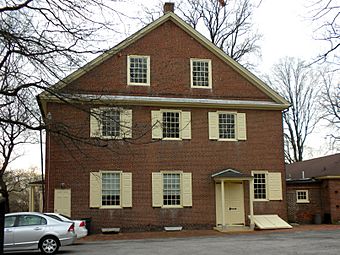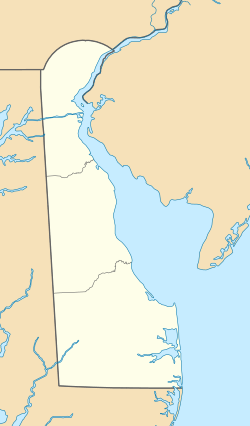Friends Meetinghouse (Wilmington, Delaware) facts for kids
Quick facts for kids |
|
|
Friends Meetinghouse
|
|
 |
|
| Location | 4th and West Sts., Wilmington, Delaware |
|---|---|
| Area | 1 acre (0.40 ha) |
| Built | 1817 |
| NRHP reference No. | 76000577 |
| Added to NRHP | November 07, 1976 |
The Friends Meetinghouse is a very old and important building in Wilmington, Delaware. It is located at 4th and West Streets in the Quaker Hill area. This building is a special place for Quakers, who are also known as the Religious Society of Friends.
Quakers are a Christian group known for their peaceful beliefs. They meet in "meetinghouses" for worship. This particular meetinghouse has about 400 members. It is part of a larger group called the Philadelphia Yearly Meeting. The Friends Meetinghouse was built between 1815 and 1817. Because of its history, it was added to the National Register of Historic Places in 1976. This means it is recognized as a significant historical site in the United States.
Contents
History of the Friends Meetinghouse
Early Quaker Gatherings in Delaware
The first Quaker worship meeting in Delaware happened a long time ago. It was in September 1672 in New Castle. A famous Quaker leader named George Fox visited the town. He held the meeting at the house of Governor Lovelace.
Later, William Penn became the owner of the land that is now Delaware. Back then, it was called the "Three Lower Counties." After Penn took over, Quakers started having regular meetings. These meetings were held in towns like Newark, Centre, and New Castle.
Quakers Come to Wilmington
Regular Quaker meetings did not start in Wilmington until 1735. That year, William and Elizabeth Shipley built a brick house. It was a one-story building near Fourth and Shipley Streets. This house was used for worship. It officially became a "Preparative Meeting" in 1738. A Preparative Meeting is a smaller group that prepares for larger meetings.
In 1750, the Wilmington Quakers were given "Monthly Meeting" status. This was granted by the Concord Quarterly Meeting. A Monthly Meeting is a more organized group that handles the community's affairs. A Quarterly Meeting is an even larger gathering of several Monthly Meetings.
Building the Meetinghouses
The first building made just for Quaker meetings in Wilmington was built in 1738. It was across the street from where the current meetinghouse stands. This first building was about 25 feet (7.6 m) square.
A second meetinghouse was built in 1748 on the current site. This building was much larger. It could hold up to 500 people. The meetinghouse you see today opened on September 25, 1817. It is said to be able to hold 700 people.
A School with Quaker Roots
A school was also started here in 1748. It began in the first meetinghouse built in 1738. This school has grown and changed over many years. Today, it is known as the Wilmington Friends School. In 1937, the school moved from the Quaker Hill neighborhood. It moved to the Alapocas neighborhood in Wilmington.
Important People Buried Here
The land next to the meetinghouse is a burial ground. Many important people are buried there. One famous person is John Dickinson. He was known as the "penman of the Revolution." He helped write important documents during the American Revolution.
Another important person buried there is Thomas Garrett. He was an abolitionist. This means he worked to end slavery. Garrett was a member of this Quaker meeting. He lived nearby on Quaker Hill. He was a very active "conductor" on the Underground Railroad. The Underground Railroad was a secret network. It helped enslaved people escape to freedom.
Thomas Garrett worked closely with Harriet Tubman. She was another brave leader of the Underground Railroad. It is believed that Garrett helped about 2,700 enslaved people find freedom. When he passed away in January 1871, about 1,500 people came to his funeral at the meetinghouse. A famous Quaker speaker named Lucretia Mott spoke at his funeral.
Also buried in the burial ground is Caleb P. Bennett. He served as a Governor of Delaware.



